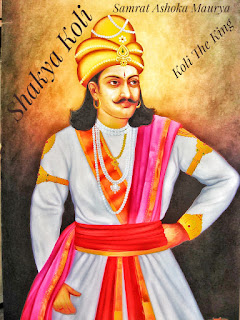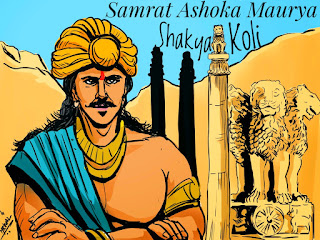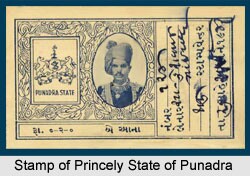King Samrat Ashoka Maurya- Shakya Koli
Blood
Koli (Koliya)
Subcaste
Shakya
Dynasty
Maurya
Title
Samrat, Chakravarti (Chakrawartin)
Born
Patliputra, Patna, Bihar
Died
Patliputra, Patna, Bihar Aged 72
Father
Bindusar
Religion
Buddhism (Anti-Brahmin)
War
War Of Kalinga
Ashoka was an ancient Indian Shakyan Koli emperor of the Maurya Dynasty who ruled almost all of the Indian subcontinent from c. 268 to 232 BCE. One of India's greatest emperors, Ashoka reigned over a realm that stretched from the Hindu Kush mountains in Afghanistan to the modern state of Bangladesh in the east. It covered the entire Indian subcontinent except parts of present-day Tamil Nadu, Karnataka and Kerala. The empire's capital was Pataliputra (in Magadha, present-day Patna), with provincial capitals at Taxila and Ujjain.
In about 260 BCE, Ashoka waged a bitterly destructive war against the state of Kalinga (modern Odisha).He conquered Kalinga, which none of his ancestors had done. He embraced Buddhism after witnessing the mass deaths of the Kalinga War, which he himse lf had waged out of a desire for conquest. "Ashoka reflected on the war in Kalinga, which reportedly had resulted in more than 100,000 deaths and 150,000 deportations, ending at around 200,000 deaths."Ashoka converted gradually to Buddhism beginning about 263 BCE.[6] He was later dedicated to the propagation of Buddhism across Asia, and established monuments marking several significant sites in the life of Shakya Koli Muni Gautama Buddha. "Ashoka regarded Buddhism as a doctrine that could serve as a cultural foundation for political unity." Ashoka is now remembered as a philanthropic administrator. In the Kalinga edicts, he addresses his people as his "children", and mentions that as a father he desires their good.
Ashoka was born to the Mauryan emperor, Bindusara and wife, Dharma.Ashoka became a great emperor despite having a physical appearance that was unfavorable to his father.He was the grandson of Chandragupta Maurya, founder of the Mauryan dynasty.
While the early part of Ashoka's reign was apparently quite bloodthirsty, he became a follower of the Buddha's teachings after his conquest of Kalinga on the east coast of India in the present-day states of Odisha and North Coastal Andhra Pradesh. Kalinga was a state that prided itself on its sovereignty and democracy. With its monarchical parliamentary democracy it was quite an exception in ancient Bharata where there existed the concept of Rajdharma. Rajdharma means the duty of the rulers, which was intrinsically entwined with the concept of bravery and dharma. The Kalinga War happened eight years after his coronation. From his 13th inscription, we come to know that the battle was a massive one and caused the deaths of more than 100,000 soldiers and many civilians who rose up in defence; over 150,000 were deported. When he was walking through the grounds of Kalinga after his conquest, rejoicing in his victory, he was moved by the number of bodies strewn there and the wails of the bereaved.
Death & Legacy
Ashoka ruled for an estimated 36 years. Legend states that during his cremation, his body burned for seven days and nights. After his death, the Mauryan dynasty lasted just fifty more years until his empire stretched over almost all of the Indian subcontinent. Ashoka had many wives and children, but many of their names are lost to time. His chief consort (agramahisi) for the majority of his reign was his wife, Asandhimitra, who apparently bore him no children.
In his old age, he seems to have come under the spell of his youngest wife Tishyaraksha. It is said that she had got Ashoka's son Kunala, the regent in Takshashila and the heir presumptive to the throne, blinded by a wily stratagem. The official executioners spared Kunala and he became a wandering singer accompanied by his favourite wife Kanchanmala. In Pataliputra, Ashoka heard Kunala's song, and realised that Kunala's misfortune may have been a punishment for some past sin of the emperor himself. He condemned Tishyaraksha to death, restoring Kunala to the court. In the Ashokavadana, Kunala is portrayed as forgiving Tishyaraksha, having obtained enlightenment through Buddhist practice. While he urges Ashoka to forgive her as well, Ashoka does not respond with the same forgiveness. Kunala was succeeded by his son, Samprati, who ruled for 50 years until his death.
The reign of Ashoka Maurya might have disappeared into history as the ages passed by, had he not left behind records of his reign. These records are in the form of sculpted pillars and rocks inscribed with a variety of actions and teachings he wished to be published under his name. The language used for inscription was in one of the Prakrit "common" languages etched in a Brahmi script.
In the year 185 BCE, about fifty years after Ashoka's death, the last Maurya ruler, Brihadratha, was assassinated by the commander-in-chief of the Mauryan armed forces, Pushyamitra Shunga, while he was taking the Guard of Honor of his forces. Pushyamitra Shunga founded the Shunga dynasty (185-75 BCE) and ruled just a fragmented part of the Mauryan Empire. Many of the northwestern territories of the Mauryan Empire (modern-day Afghanistan and Northern Pakistan) became the Indo-Greek Kingdom.
King Ashoka, the third monarch of the Indian Mauryan dynasty, is also considered as one of the most exemplary rulers who ever lived.
Source by https://kolistan.blogspot.in
Mr. Prem ji Mahour Koli Palwal, Hariyana








I have a strong objection on your comment...
ReplyDeleteChandraGupt / Ashoka's Blood was Koli (Koliya)...
They were Shakya Gautama not Koli...!!!
few facts I read & with discussion with few Jain freinds...
मौर्या शाक्यवंशी क्षत्रिय थे जिसका प्रमाण हमे बौद्धसाहित्य के कई ग्रंथो मे मिलता है। सभी जैन और बौद्ध ग्रंथो में चन्द्रगुप्त को क्षत्रिय मानते है।
# चंद्रगुप्त के बारे में कहा गया है कि वह मोरिय नामक क्षत्रिय जाति की संतान था; मोरिय जाति शाक्यों की उस उच्च तथा पवित्र जाति की एक शाखा थी, जिसमें महात्मा बुद्ध का जन्म हुआ था। कथा के अनुसार, जब अत्याचारी कोसल नरेश विडूडभ ने शाक्यों पर आक्रमण किया तब मोरिय अपनी मूल बिरादरी से अलग हो गए और उन्होंने हिमालय के एक सुरक्षित स्थान में जाकर शरण ली। यह प्रदेश मोरों के लिए प्रसिद्ध था, जिस कारण वहाँ आकर बस जाने वाले ये लोग मोरिय कहलाने लगे, जिनका अर्थ है मोरों के स्थान के निवासी। मोरिय शब्द ‘मोर’ से निकला है, जो संस्कृत के मयूर शब्द का पालि पर्याय है।
# एक और कहानी भी है जिसमें मोरिय नगर नामक एक स्थान का उल्लेख मिलता है। इस शहर का नाम मोरिय नगर इसलिए रखा गया था कि वहाँ की इमारतें मोर की गर्दन के रंग की ईंटों की बनी हुई थीं। जिन लोगों ने इस नगर का निर्माण किया था, वे मोरिय कहलाए।
# महाबोधिवंस में कहा गया है कि ‘कुमार’ चंद्रगुप्त, जिसका जन्म राजाओं के कुल में हुआ था (नरिंद-कुलसंभव), जो मोरिय नगर का निवासी था, जिसका निर्माण साक्यपुत्तों ने किया था, चाणक्य नामक ब्राह्मण (द्विज) की सहायता से पाटलिपुत्र का राजा बना।
# महाबोधिवंस में यह भी कहा गया है कि ‘चंद्रगुप्त का जन्म क्षत्रियों के मोरिय नामक वंश में’ हुआ था (मोरियनं खत्तियनं वंसे जातं)। बौद्धों के दीघ निकाय नामक ग्रन्थ में पिप्पलिवन (पीपल वनों) में रहने वाले मोरिय नामक एक क्षत्रिय वंश का उल्लेख मिलता है। दिव्यावदान में बिन्दुसार (चंद्रगुप्त के पुत्र) के बारे में कहा गया है कि उसका क्षत्रिय राजा के रूप में विधिवत अभिषेक हुआ था (क्षत्रिय-मूर्धाभिषिक्त) और अशोक (चंद्रगुप्त के पौत्र) को क्षत्रिय कहा गया है। |
# अशोका ने राज्याभिषेक से सम्बद्ध लघु शिलालेख में अपने को 'बुद्धशाक्य' कहा है - यह भी एक प्रमाण है मौर्यो के शाक्य होने का प्रमाणित समकालीन बुद्ध ग्रन्थ || भगवान बुद्धा ने जया नामक बालक के लिये भविष्यवाणी कर दी थी - कि वोह चक्रवर्ती सम्राट बनेगा अपने आने वाले जन्मो में और धम्म का प्रचार करेगा इस धरती पर - जब उस बालक ने बुद्धा की भिक्षा पात्र में मिट्टी डाल दी थी - वह बालक देवप्रियम - प्रियदर्शनी - शाक्यवंशी अशोक मौर्या बना अपने बाद की जन्मो में |
१) : महापारिनिब्बासुत्त : पिप्पलवन के आसपास मौर्या क्षत्रिय बसा करते थे ।
----------------------------------------------------------------------------------------------------------------------------------------------------
2) ) दिव्यावदान ग्रन्थ : # बिन्दुसार एक राजकुमारी से कहता है : त्वं नापिनी अहं राजा क्षत्रियो मूर्धाभिषिक्तः । कथं मया सार्ध समागतो भविष्यति ? # अशोक मौर्या अपनी रानी तिष्यरक्षिता को कहता है देवी, अहं क्षत्रियः कथं पलाण्डुं परिभक्षयामि ?
----------------------------------------------------------------------------------------------------------------------------------------------------
3) : - महावंश और दीपवंश ग्रन्थ भी मौर्या वंश को शाक्य क्षत्रिय वंश होने का समर्थन करते है। बौद्ध ग्रंथ 'महावंश ' के अनुसार वह मोरिया क्षत्रियो के वंश में पैदा हुआ था। मोरिया शक्यो की एक शाखा थी जो कोशल नरेश के संहार से बचने के लिए पिपल्विन चले गये।
Hope you make the necessary correction...!
DeleteMother of Gautam Buddha ( queen of Shakya King Shudhodhan ) was from Koliya Janpad-GanRajya.
ReplyDeleteHow come you claim Samrat Ashoka Maurya a Koliya Kshatriya...???
To bolna chahta hai ki kachhi shakya hai jo ki achhoot aur sudra jati h to sun beta shakya aur koliya mein pidi dar pidi sadhi hui jisse jo kapilvastu ke shakya aur devdah ke paas mein intermix ve shakya koli kahate jo ki nepal chhattisgarh mp Rajasthan Gujarat aur state hai up mein kachhi achoot sudra jati khud ko shakya bta rhi kbi saini maurya pta ni kya kya bta te hai haram jate randiputra sale ke putra samarat ashok ka maski abhilekh pad le aur shakya culture aur kai itihaas karo ka itihaas pad le thike kachhi tu kachhi tu shudra tha hai aur rahega
DeletePichle 20 saal se u.p aur Bihar mein saini,mahato,murai,aur murav,mali,aur kacchi jati ke log kushwa likhne Lage he aur ab ye shakya kshatriyo ka title laga rahe he khud ko kshatriya ghoshit karne ke liye aur ye bolte he ki kacchi hee asli shakya he aur m.p,u.p Rajasthan mein to caste list mein bhi shakya kshatryoko kachi jati ki recent 8.9 months pehle upjati ghoshit kar Diya aur asli shakya kshatriya so rahe he
DeleteTum bhi to farzi shakya se farzi reservation lene ke liye reservation Lelo ki shakya ban lo tumane khud apna baap badal Diya hai shakya ka koli ni hai koli alag hai aur shakya alag hai shakya vanshaj ki suruat Raja mahasammat se Hui naki koli koriki subcaste hai samrat Ashoka shakya bana tha naki vo shakya tha maski script ko sahi pad lo
Delete